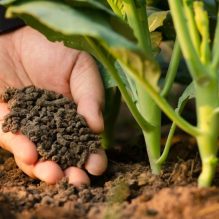
Fertilizer: A Plant’s Best Friend
When I first started planting vegetables, I always thought all you need was some potting soil and add some water. That’s it. I never bothered to add fertilizer to any of them. I always thought it just a way of being fancy or some optional boost if you wanted your plant to grow faster or something. Only recently did I realize that good nutritious soil is essential to a good fruiting plant, and it starts with adding good fertilizer.
This made a lot of sense now. Most of my plants before never really fruited or were dwarfed. I never gave the soil in those pots any vital nutrients. Container plants not only need more watering, but they also require more nutrients. When you water the plants, you also wash away the excess nutrients in the soil. Thus the plants require constant feeding than do landscape plants. The soil is the thing that makes or breaks the plant. If you add fertilizer, you enrich the soil.
When you buy fertilizer at the stores, they will have a sequence a numbers, like 4-4-4 for example. The order of these numbers represents nitrogen, phosphorus, and potassium. Tomatoes would benefit from a ratio of 4-6-2 because they require more phosphorus than nitrogen. In some cases, heavy nitrogen can lead to lush leaf but little fruit production. Some plants do fine without any nutritional assistance. For example, my most fruitful and abundant plants were the bush beans (green beans) , because they produce their own nitrogen.
Determined to get this garden going again, I invested in some fertilizer. I want to be as organic as possible, so I bought this:

This is what you would use for tomatoes or bell pepper plants, but the worker at my local nursery said I could use it for virtually any plant. Just add about 1/4-1/2 cup of fertilizer on the top of the soil. Then water the soil so the fertilizer can dissolve. This is what it looked the the first time I did it.

Then a couple weeks later, I transplanted pretty much all my plants into new pots. This time I put the same amount of fertilizer at the bottom of the plant. Also I used a 4-4-4 fertilizer instead, mostly because I had used much of the other one up and I found one hidden on my porch. I found out later that by putting the soil at the bottom, I probably have been washing out the fertilizer faster with each wash since it is so close to the drainage holes.
After a couple of weeks, the plants looked like they have been growing at the same pace. The bell peppers haven’t grown much at all.
After some research I found out that container plants need much more consistent feeding than landscape plants. My original idea was to fertilize the plants every three weeks, but it might have to be weekly.
There’s other types of fertilizer besides the granular, dry stuff. Slow release fertilizer are pellets that release fertilizer over an extended period of time and need only be applied twice a season. Then there’s the liquid fertilizer, the only downside is that you would have to feed more frequently using this method. I do have an in-the-works compost pile, but that is a whole other topic on its own.
This is all for the fertilizing portion of this blog. Mind you this is the 1st month I’ve used fertilizer EVER so I still have a lot of trial and error to do. So if you’re lost on this topic, trust me that I am still lost with you. But let’s all just do the right thing and feed our plants.

